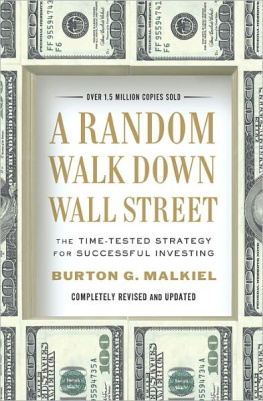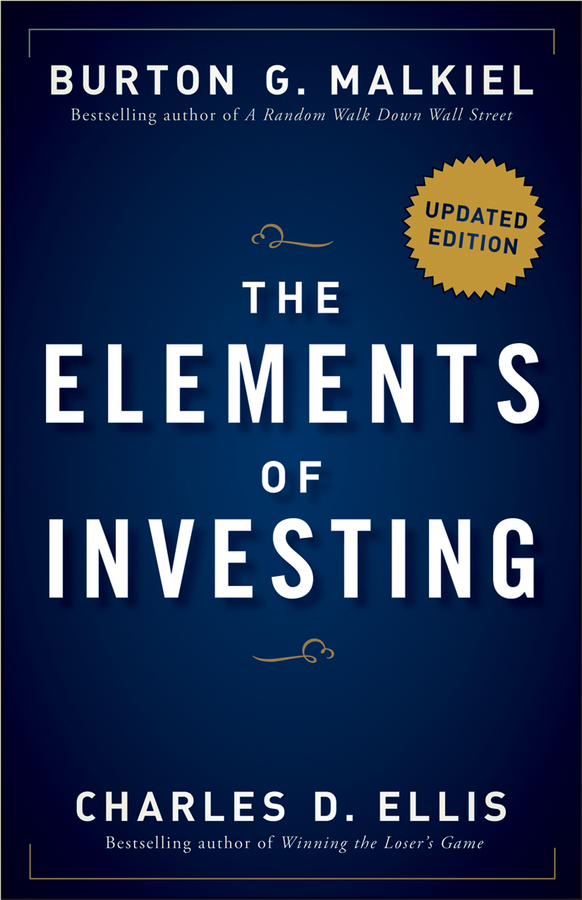CONTENTS

Cover design: John Wiley & Sons, Inc.
Copyright 2013 by Burton G. Malkiel and Charles D. Ellis. All rights reserved.
Published by John Wiley & Sons, Inc., Hoboken, New Jersey.
First Edition published by John Wiley & Sons, Inc. in 2010.
Published simultaneously in Canada.
No part of this publication may be reproduced, stored in a retrieval system, or transmitted in any form or by any means, electronic, mechanical, photocopying, recording, scanning, or otherwise, except as permitted under Section 107 or 108 of the 1976 United States Copyright Act, without either the prior written permission of the Publisher, or authorization through payment of the appropriate per-copy fee to the Copyright Clearance Center, Inc., 222 Rosewood Drive, Danvers, MA 01923, (978) 750-8400, fax (978) 646-8600, or on the Web at www.copyright.com . Requests to the Publisher for permission should be addressed to the Permissions Department, John Wiley & Sons, Inc., 111 River Street, Hoboken, NJ 07030, (201) 748-6011, fax (201) 748-6008, or online at http://www.wiley.com/go/permissions .
Limit of Liability/Disclaimer of Warranty: While the publisher and author have used their best efforts in preparing this book, they make no representations or warranties with respect to the accuracy or completeness of the contents of this book and specifically disclaim any implied warranties of merchantability or fitness for a particular purpose. No warranty may be created or extended by sales representatives or written sales materials. The advice and strategies contained herein may not be suitable for your situation. You should consult with a professional where appropriate. Neither the publisher nor author shall be liable for any loss of profit or any other commercial damages, including but not limited to special, incidental, consequential, or other damages.
For general information on our other products and services or for technical support, please contact our Customer Care Department within the United States at (800) 762-2974, outside the United States at (317) 572-3993 or fax (317) 572-4002.
Wiley publishes in a variety of print and electronic formats and by print-on-demand. Some material included with standard print versions of this book may not be included in e-books or in print-on-demand. If this book refers to media such as a CD or DVD that is not included in the version you purchased, you may download this material at http://booksupport.wiley.com . For more information about Wiley products, visit www.wiley.com .
ISBN 978-1-118-48487-6 (cloth); ISBN 978-1-118-55374-9 (ebk);
ISBN 978-1-118-55375-6 (ebk); ISBN 978-1-118-63294-9 (ebk)
To our delightful grandchildren, Porter, Mackie, George, Jade, Morgan, Charles, and Ray
PREFACE TO UPDATED EDITION
At her death in 1999, at the age of 91, Oseola McCarty bequeathed $150,000 to the University of Southern Mississippi. For her generosity, she received an honorary degree from the university and the Presidential Citizens Medal, the second highest civilian award in the United States. Her gift was all the more extraordinary because she earned her living washing clothes.
At a very young age, Ms. McCarty was taught by her mother to be a great saver. She made tradeoffs, spending what she needed to live on, but forgoing any luxuries. She had a used TV, but only watched shows that she could pick up over the airwaves. She did not own a car, electing to walk everywhere. She lived in a house that she inherited from her uncle. Over the course of her lifetime, she amassed a remarkable nest egg, estimated to be about $250,000.
Ms. McCarty was the very model of a disciplined saver. Her example shows that a little bit of will powerand yes, thriftcan add up to big things. This is Lesson No. 1 in any sound financial plan, and it is Lesson No. 1 in this wonderful book by Burton G. Malkiel and Charles D. Ellis.
Over the past several decades, Malkiels Random Walk Down Wall Street and Elliss Winning the Losers Game have helped millions of people to understand the fundamentals of investing and to reach their financial goals. In Elements of Investing , Malkiel and Ellis distill their wisdom and experience into a sensible plan for people to save and invest.
Some money managers warn that successful investing can be carried out only by the most sophisticated and talented professionals. And, of course, these managers claim to be members of that small club. Malkiel and Ellis argue that successful investing should not be the province of a select few. Football games are not always won by the best quarterback. They are won in the trenches. Investors have to win the war of blocking and tackling.
Elements of Investing provides a road map that can multiply your savings to reach your financial target. It starts with understanding the answers to some basic questions, like when will you need this money? And how well can you tolerate investment risk? The answers to those questions can help you build an appropriate asset allocation between stocks, bonds, and cash.
It should be a balanced approach, and the investments should be broadly diversified. Most importantly, the authors stress that the investments must be low cost. One certainty about investing is that, for a given return, the more you spend to earn it, the less of it you will keep. The authors conclude that the best way to implement your plan is to invest in low-cost index funds.
This approach is certainly not sexy. Blocking and tackling is not sexy. But, I daresay that most investors would be better off if they followed this strategy. Indeed, its the kind of approach that we espouse at Vanguard. It has served many clients very well over the years.
This updated edition of Elements of Investing brings a clear-eyed perspective to the current environment, including a new chapter describing the aftermath of the global financial crisis, and its impact on the way people are rethinking their approach to investing. Pundits bombard us with claims that the old rules no longer apply. They say that we are in a protracted environment of low returns and high volatility, and that people should abandon buy-and-hold investing and become more opportunistic. Malkiel and Ellis take umbrage with these claims, and at Vanguard, so do we.
The authors reaffirm the views they expressed in the first edition and they provide supporting evidence. Diversification, rebalancing, dollar-cost averaging, and low-cost indexing remain the best path to achieve investment success.
This book is a must-read for all investorsthose new to investing and those who have been at it for a while. It should be required reading in high school because the power of compounding is particularly valuable at a young age. But veteran investors will also benefit from reading this book as it debunks many misconceptions and identifies behavioral biases that stand in the way of successful investing. And, just to make sure you do not fall prey to the sirens song of a better way, you should reread this book every several years.
Over the course of my career, Ive seen time and again how the simple principles discussed in this book have helped ordinary people achieve extraordinary results.
George U. Gus Sauter
Chief Investment Officer, Vanguard
October 2012
FOREWORD
In The Elements of Investing , Charley Ellis and Burt Malkiel, two of the investment worlds greatest thinkers, combine their talents to produce a remarkable guide to personal finance. Having already written two of the finest books on financial markets, Elliss Winning the Losers Game and Malkiels A Random Walk Down Wall Street , why should the authors revisit the subject of their already classic volumes? The sad fact is that in the cacophony of advice for individual investors, few sane voices are raised. In writing The Elements of Investing , the authors provide an important service to the lay reader, honing their message to the bare essentials by heeding Albert Einsteins dictum that everything should be made as simple as possible, but not simpler.







